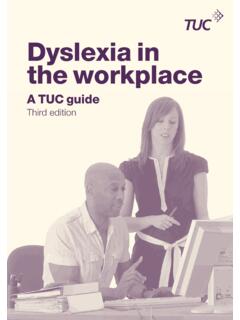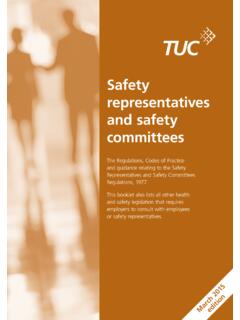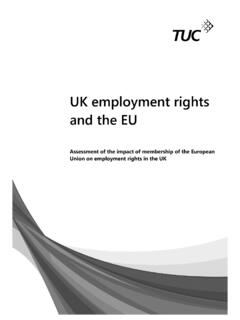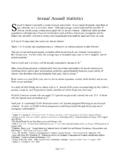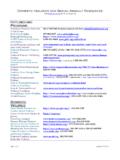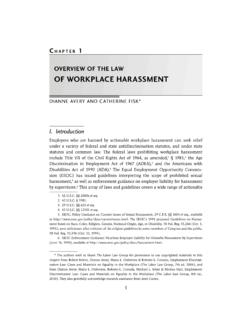Transcription of Still just a bit of banter? - TUC
1 Still just a bit of banter ? sexual harassment in the workplace in 2016 In association with 2 Contents 3 Foreword 4 Executive summary 6 What we know about sexual harassment Defining sexual harassment What we know about the extent of sexual harassment What do we know about who is affected by sexual harassment? just a bit of banter ? 12 TUC research findings Incidence Characteristics of respondents and their workplaces Characteristics of perpetrators Where the harassment took place Reporting harassment Impact 28 Recommendations Recommendations for government Recommendations for employers Recommendations for trade unions 33 Further sources of support and information 34 References Trades Union Congress Still just a bit of banter ?
2 3 1 Foreword How many times have we heard sexual harassment in the workplace dismissed as just a bit of banter ? It may seem like a joke or even a compliment to those who have never experienced it but those who have will know just how undermining, humiliating and sometimes terrifying it can be. While trade unionists have never been in any doubt about the scale of the problem - dealing with cases of sexual harassment in the workplace is the bread and butter work of many union reps evidence can be hard to come by. This TUC report, based on polling and the experiences of trade union members, gives us both the numbers and the voices to tell the real story.
3 The trade union movement faces a big challenge. Of all the alarming statistics thrown up by the polling, the fact that jumps out for me is that only one per cent of those women who had experienced sexual harassment confided in their union rep. The report also tells us that sexual harassment is more prevalent for younger women, and those in precarious forms of work such as zero hours contracts and agency work precisely those who are much less likely to belong to a trade union. The lessons are clear. We must do more to get the message out to our members that sexual harassment will not be tolerated and that their union will support them.
4 And we must reach out to the army of young women in casual work who have never worked in a unionised workplace. By organising and winning agreements, we can help stamp out sexual harassment once and for all. That s the best way to ensure that everyone has the right to respect and wellbeing at work. Frances O Grady General Secretary, TUCE xecutive summary Trades Union Congress Still just a bit of banter ? 4 2 Executive summary The TUC undertook this research in collaboration with the Everyday Sexism project in response to the paucity of up-to-date, quantitative data on sexual harassment in the workplace.
5 Trade unions represent nearly six million workers in the UK, about half of whom are women, so the importance of unions in challenging harassment in the workplace is clear. By working with the Everyday Sexism project the TUC aims to reach out to younger women who, as this report shows, are more likely to experience sexual harassment yet, as trade union membership statistics show, are less likely to be a member of a trade union. While unions and women s organisations are in no doubt that sexual harassment remains as widespread a problem as ever, there has been little in the way of empirical data to quantify the problem.
6 There already exists a wealth of evidence about women s experiences of sexual harassment and how their experiences affect them both emotionally and professionally. Trade unions are well aware not just of the scale of the problem but of the significant impact that it can have on the lives of those affected. By commissioning polling and also gathering testimonies from union members via an online survey about their experiences of sexual harassment, this report explores both the nature and the scope of the problem and shines a light on an issue which is too often overlooked and underestimated.
7 Key findings relating to the extent of sexual harassment in modern workplaces are: More than half (fifty two per cent) of all women polled have experienced some form of sexual harassment. Thirty-five per cent of women have heard comments of a sexual nature being made about other women in the workplace. Thirty-two per cent of women have been subject to unwelcome jokes of a sexual nature. Twenty-eight per cent of women have been subject to comments of a sexual nature about their body or clothes. Nearly one quarter of women have experienced unwanted touching (such as a hand on the knee or lower back).
8 One fifth of women have experienced unwanted sexual advances. Trades Union Congress Still just a bit of banter ? 5 More than one in ten women reported experiencing unwanted sexual touching or attempts to kiss them. In the vast majority of cases, the perpetrator was a male colleague, with nearly one in five reporting that their direct manager or someone else with direct authority over them was the perpetrator. Four out of five women did not report the sexual harassment to their employer. just because sexual harassment in the workplace is has proven to be a tough nut to crack, it does not mean it is an intractable problem.
9 Action by employers, backed up by stronger legal protections for workers, better access to justice, and strong unions, are all part of the solution. The final section of this report sets out clear recommendations to government, employers and unions. Recommendations for government Abolition of employment tribunal fees Reinstatement of third party harassment legislation Reinstatement of employment tribunal powers to make wider recommendations Reinstatement of Statutory Equality Questionnaire Recognition and facility time for union equality reps Extend full range of statutory employment rights to all workers, regardless of employment status or type of contract.
10 Recommendations for employers Decent jobs Training Clear policies Implementation and enforcement of policies. Recommendations for trade unions Training Workplace campaigns Negotiating workplace we know about sexual harassment Trades Union Congress Still just a bit of banter ? 6 3 What we know about sexual harassment Defining sexual harassment This report focuses on sexual harassment, rather than other forms of discrimination and harassment such as sex-based harassment1, or harassment on the grounds of sexual orientation but it is worth noting that there in some cases the delineation between different types of harassment may not be clear.
